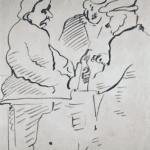The exhibition of paintings by Victor Khromin will bring together twenty-seven works from the artist’s collection and TMORA’s permanent collection. Merging sculpture’s capacity for representing the three-dimensionality of objects with painting’s power to express content in color, Victor Khromin’s remarkable works explore the boundary between painting and sculpture. His paintings done in oils against the bas-relief of the background hover between two registers – exploiting both, committing to none. Victor’s sculpted surfaces are created using molds of found objects such as buckles, belts, bags, wheels, wire and other items. In Kromin’s work, the mingling of painting and sculpture is sustained at an uneasy balance. The polychrome world of painting engulfs the sculpted background, the latter slowly liberating itself from the dominance of the color as the eye of a viewer becomes accustomed to the two-layered presentation. In this sense, Victor Khromin’s art is intervisual as it strives to combine two distinct visual experiences: perceiving the flatness of color patches and the sculpted background.
Born into a Russian-Finnish family in the town of Gatchina near Leningrad, Victor was trained as an artist at the Serov Art School in Leningrad (now St. Petersburg). While still a student, he participated in unofficial exhibitions of non-conformist art. In 1976, Victor became a member of the USSR Artists Union. His exhibition held in Berlin in 1985 put him in a difficult position within the Union: Union artists were not supposed to exhibit their work independently outside the country. Gorbachev’s reforms irrevocably changed the Soviet art establishment creating opportunities to exhibit. Between 1985 and 1990, Victor showed his work at the “From Unofficial Art to Perestroika” in his native Leningrad, as well as Zurich, Paris, New York (Zimmerly Art Museum), Latvia and Estonia.
In 1990, Victor received an invitation to come to New York City to show his work and stayed in the United States. In 1996, Victor’s paintings became part of the Norton and Nancy Dodge Collection of Nonconformist Art at Rutgers University. At that time, Victor and his family moved to rural upstate New York. Here, in the Catskill Mountains, Victor continues developing his unique techniques characterized by his inventive use of three-dimensional casts for oil paintings and hand made paper relief.


